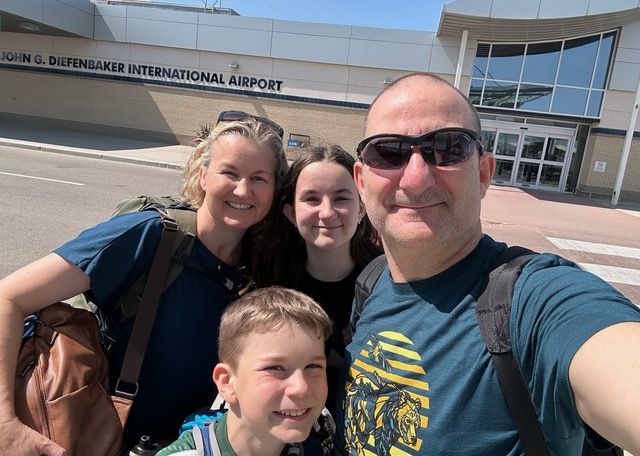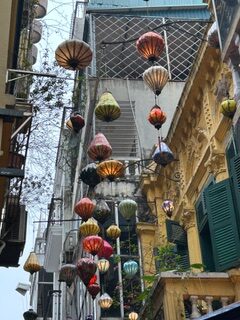On our first day in Hanoi, Alastair and I left the kids to catch up on their schoolwork while we took a three-hour history of Vietnam and the Vietnam war tour. As it was low season, our tour ended up being private tour, we had an excellent young and informative tour guide, Kein. He had spent a year studying in the Wisconsin and had spent one year studying architecture in Dublin Ireland. He returned home urgently because both of his parents were hospitalized with Dunge fever, joking he never returned as school, wasn’t really for him. He aspires to start his own tour company someday and would likely be very successful. He shared that after being away from Vietnam for a few years, he was happy to discover some of the changes in Vietnam, commenting much the quality of life had improved dramatically during the year he had been away.
Kein did a wonderful job of sharing the long history of Vietnam as well as giving us a great understanding of his life as a young person today living in Hanoi. We learned a lot about war in Vietnam, dating back to the Mongolian era, China’s desire for their coast and waterways, Cambodia, Laos, Thailand, and the experience of colonization under French Indochina. He added antidotes from his family and friends and community members during our walking tour. He also showed us pictures of changing geographical borders overtime. Vietnam has now been at peace since 1979, after their last defence against Cambodia when they tempted to invade in the wake of Vietnams recovery from the lengthy Vietnam war. Kein joked that Vietnam “is the least communist country”, despite having a communist government since 1975, he elaborated that while we are visiting, we will experience lots of free enterprising businesses. With more questions we learned that individuals must pay for all levels of school, healthcare, and there is very little social security, with the occasional exception for those who have disability from the Vietnam war or because of Agent Orange. The communist party is the one ruling party, and no other party can run against them. There are four leaders within the party President, Prime Minister, General Administrator, and the Party Leader. These leaders can put check and balances on each other, they all have similar agenda, Kein felt the General Administrator had the most power. From his perspective because the quality of life continues to improve in Vietnam and people have the capacity to build their businesses and personal wealth. People are generally happy with the communist leadership.
Kein explained the evolution of the black market during the period with strong communist rule, and how it evolves to be very in Northern Vietnam during the long Vietnam war. Our tour took us to this market, which still has a pivotal role in Hanoi society. He told us about the corruption in South Vietnam before the war, the protests and poverty as the corrupt presidents where stealing from the people. He showed us the famous image of a Monk lighting himself on fire and in Saigon to protest the corruption of the South Vietnamese president who was incredibly corrupt. He went on to share the nasty comments the president sister-in-law had made about this incident and the following assassination of the corrupt leader. He provided background on how and why the resistance movement in South became so strong. Kein also provided background for why Ho Chi Min was considered such and hero and clearly remains a hero in the country (adorning all the currency), despite the controversy over his actions and his role in mass graves found South Vietnam. I have used some of the heartbreaking images he shared with us about the effects of agent orange and the massive record of the bombs dropped on Vietnam by the United States – black dots over the map, over this 20 year battle.
We toured the government housing located in a very central area of Hanoi. The style, apartment blocks with thick concrete walls, very low roofs, little ventilation, minimal windows, and many fire safety hazards. He explained to our surprised that the apartments in these building are still worth a surprising amount of money, he explained many people who live in these apartments are much wealthier than it would appear. He described how the Vietnamese tend to hide their success, keeping the doors of the apartments closed despite inside having many belongings that would suggest wealth and luxury. He greeted many people along the way as we were walking, telling us interesting antidotes about people’s lives, family, and how the Vietnamese society works. As someone who has lived away for several years, he had great insight into what would be interesting for us.
He provided many details about the Vietnam war the respect that Vietnam has for John McCain, who was here as a Prisoner of War, and returned later with a message of peace and acknowledgement regarding the damage of the American bombing campaigns and Agent Orange. He explained people in Vietnam blame President Nixon, more than the American people, showing us, pictures of the protestors fighting the US decision not to withdraw from Vietnam much earlier. He took us to the moving Christmas Bombing Memorial showing a woman holding her dead child and stepping on the head of a bomb, to signify that no matter how much the Americans bombed Vietnam they would not give up. Kein also explained the Vietnamese tradition of trying to live in the here and now, not focussing on the past. He believes this has helped prevent generations anger and rage about what happened to the country during the Vietnam war and the many years of poverty following the war made worse by harsh international trade embargoes. He compared what Vietnam had experienced to what Cuba experiences.
An antidote he told us about the Skye market where things seem to fall out of the sky discussing of frequently things such as bikes, car parts and scooters were stolen. Petty crime is rampant in Vietnam, this has been improving dramatically over the last 5 to 6 years. We will still need to be careful of pick pockets and Taxicab drivers a lesson we had reinforce on our way home that evening. Interestingly we had great difficulty getting back to our accommodation during rush hour our attempts to use Grab (southeast Asia’s Uber) with 11 different rides booked and then immediately canceled by different drivers, (apparently a common problem in Vietnam). A cab driver who told us he would be using a metre then refused to use the metre that was broken in his cab using a private metre on his iPhone, then attempting to charge us 10 times what we paid to get to location that was even further away for the start of our tour. We ended up paying an exorbitant fair, but not as much as he was asking.
We enjoyed an interesting Vietnam food tour through the old quarter of Hanoi. Highlights were trying different types of Pho, Banh Mi (banquette sandwich with pate, pork, salad and sweet sauce), fresh spring rolls, including papaya, salad, mangoes, pork, and deep-fried rice paper. The dessert that was featured rice with coconut milk and green rice. Our guide encouraged us to stick to rice-based desserts explaining many tourists found other Vietnamese desserts slimy and sweet. Many of the places we visited were holes in the wall, found by travelling through winding alleys, we enjoyed watching an interesting family food prep line down one of the alleyways. Street food and small family restaurants in Vietnam are relatively cheap and many of the local eat out regularly.
Our tour ended on the famous train Street pictures and video say it all. It is very disconcerting to be this close to a rapidly moving train. It is very hard to believe no one has been hurt.
We visited the Vietnam Women’s Museum in Hanoi. It provided an interesting overview of courtship, marriage, and traditions about childrearing through several different hill tribe societies in Vietnam. It also gave an excellent description of women’s roles in the revolution during the Vietnam war and some of the female war heroes. This museum like the communist museum in Dubrovnik was a little bit one-sided. Seeing the different fashion and weaving, as well as the ornate wedding attire and infant carriers from the different hill tribes and learning about the immense amount of work that goes into creating these objects was fascinated.
While in Hanoi we also visited Kiem Lake seeing the famous red bridge and Turtle Tower (Thap Rua) in the centre of the lake.












































